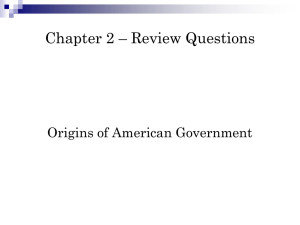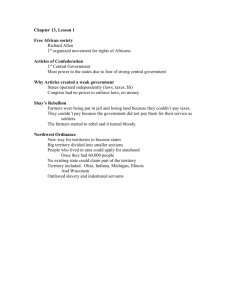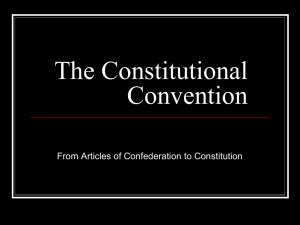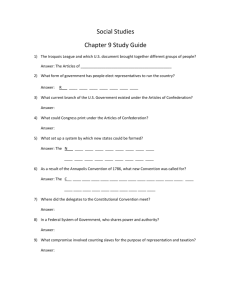American Government Chapter 2 Origins of American Government
advertisement
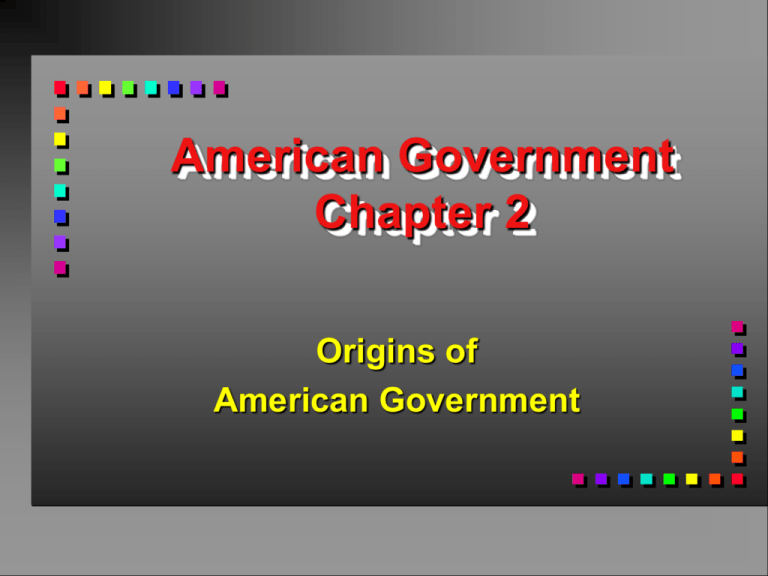
American Government Chapter 2 Origins of American Government Our Political Beginnings Three Basic Ideas From England 1. Ordered governments Government rules help people get along 2. Limited government Government powers are limited 3. Representative Government People tell the government what they can and cannot do Important English Documents Magna Carta: signed in 1215 The king did not have total power. Led to the Establishment of Parliament Petition of Right: signed in 1628 King could not use the military to rule in peacetime English Bill of Rights: signed in 1689 Guaranteed a fair and speedy trial and free parliamentary elections Government in the Colonies The government in each of the 13 American Colonies started with a charter. A charter gave them the power to rule. Three Types of Colonies Royal Colonies The British king controlled these colonies Proprietary Colonies Established by wealthy owners who received land from the king. Charter Colonies the Self-governing, the king gave the people land to form colony The Coming of Independence Growing Colonial Unity 1. Albany Plan of Union 2. Stamp Act Congress 3. 1st Continental Congress (1774) 4. 2nd Continental Congress (1775) 5. Declaration of Independence (1776) 6. Articles of Confederation (1781) The First State Governments 1. 2. 3. 4. 5. The New State Constitutions has These Common Ideas Limited Government Civil rights and liberties Separation of Powers Checks and balances Popular sovereignty The Critical Period The First National Constitution 1. The Articles of Confederation (1781) 2. Had little power 3. One branch Government (Legislature) 4. Each State had one vote 5. Had no way to force the states to obey the articles or the laws that it passed. Powers of the Confederation 1. Make war and peace 2. Send and receive ambassadors 3. Make treaties 4. Set up a monetary system 5. Borrow money 6. Build a navy 7. Raise an army 8. Fix universal standard weights and measures 9. Settle disputes among the states Weaknesses of the Confederation 1. One Vote per state 2. Congress powerless to collect taxes 3. Congress powerless to regulate foreign or interstate trade 4. No executive to enforce acts of Congress 5. No National Court System 6. Amendments only with consent of all of the states 7. A 9/13 majority required to pass laws 8. Articles of Confederation only a “firm league of Friendship” Attempts to Fix the Articles I. Mount Vernon Convention: Meetings held between delegates from Maryland and Virginia to solve their trade problems II. Annapolis Convention: A nation wide conference held to examine and correct the nation’s problems. Only five states sent delegates. III. Philadelphia Convention: Scheduled for the summer of 1787. This time 12 states sent delegates. This convention became know as the Constitutional Convention. Creating the Constitution The Decision to Write a New Constitution 1. 56 delegates or Framers representing 12 states make the decision that the Articles of Confederation cannot be fixed. These men represent a new wave of leadership in American government. 2. They got ideas for the new Constitution from many sources, such as ancient Greek and Roman Governments, and from 17th Century political philosophers like Montesquieu (French) and Locke (English) 3. Many older revolutionary leaders boycotted the convention. The Virginia Plan 1. Written by James Madison 2. Called for three separate branches in the government Executive, Legislative, and Judicial 3. Representation in congress was based on population 4. Called for Bicameral Congress (2 houses) 5. States with larger populations favored this plan The New Jersey Plan 1. Written by William Paterson 2. No separation of powers 3. A Unicameral legislature (one house) 4. Equal representation in Congress 5. States with smaller populations favored this plan The Compromises Arguments over how congress should be setup lead to a stalemate at the convention. Many delegates threatened to leave the convention. Connecticut Compromise: Settled the issue of congress by establishing a Bi-cameral Congress Senate (Equal representation) House (Representation based on Population Three distinct and separate branches of government More Compromises 3/5 Compromise: Settled the issue of how African American slaves would be counted in the population for representation in Congress. Southern slave states wish to count all slaves. Non Slaves states opposed this. In the end 60% of all slaves were counted Commerce and Slave Trade: Compromise: Forbid the taxing of Exports. No action would be taken against the slave trade for 20 years Ratifying the Constitution The framers of the new Constitution decide that 9 states would have to approve the Constitution before it would go into effect. Two Groups Formed in Regards to the Constitution 1. The Federalists A. Favored the Constitution) B. James Madison & Alexander Hamilton C. They believed that the Constitution was strong enough to solve the country’s problems D. Wrote the Federalists Papers Ratification (Continued) 2. Anti-Federalists A. Opposed the Constitution B. Led by Patrick Henry and John Hancock C. Believed the Constitution was too strong. Wanted a bill of rights add to protect individual freedoms The ratification process was completed in 1788 and the states held elections. The new government met in March 1789 in New York City. George Washington was elected President by the Electoral College.


